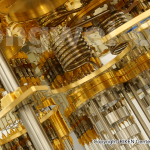The new architecture reduces the number of physical qubits required for quantum error correction – a prerequisite for the realisation of fault-tolerant quantum computing – by 90% from 1 million to 10,000 qubits.
This breakthrough will allow research to embark on the construction of a quantum computer with 10,000 physical qubits and 64 logical qubits, which corresponds to a computing performance of approximately 100,000 times that of the peak performance of conventional high performance computers.
Fujitsu and Osaka University will further refine this new architecture to lead the development of quantum computers in the early FTQC era, with the aim of applying quantum computing applications to a wide range of practical societal issues including material development and
Logical qubits, which consist of multiple physical qubits, play a major key role in quantum error correction technology, and ultimately the realisation of practical quantum computers that can provide fault-tolerant results.
Within conventional quantum computing architectures, calculations are performed using a combination of four error-corrected universal quantum gates (CNOT, H, S, and T gate).
Within these architectures, especially quantum error correction for T-gates requires a large number of physical qubits, and rotation of the state vector in the quantum calculation requires repeated logical T-gate operations for approximately fifty times on average.
Thus, the realization of a genuine fault-tolerant quantum computer is estimated to require more than one million physical qubits in total.
For this reason, quantum computers in the early FTQC era using conventional architecture for quantum error correction can only conduct calculations on a very limited scale below that of classical computers, as they work with a maximum of about 10,000 physical qubits, a number far below that required for genuine, fault-tolerant quantum computing.
In contrast to conventional architectures that required repeated logical T-gate operations using a large number of physical qubits, gate operation within the new architecture is performed by phase rotating directly to any specified angle.